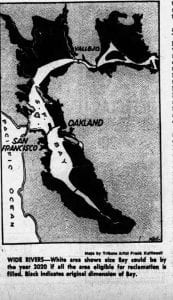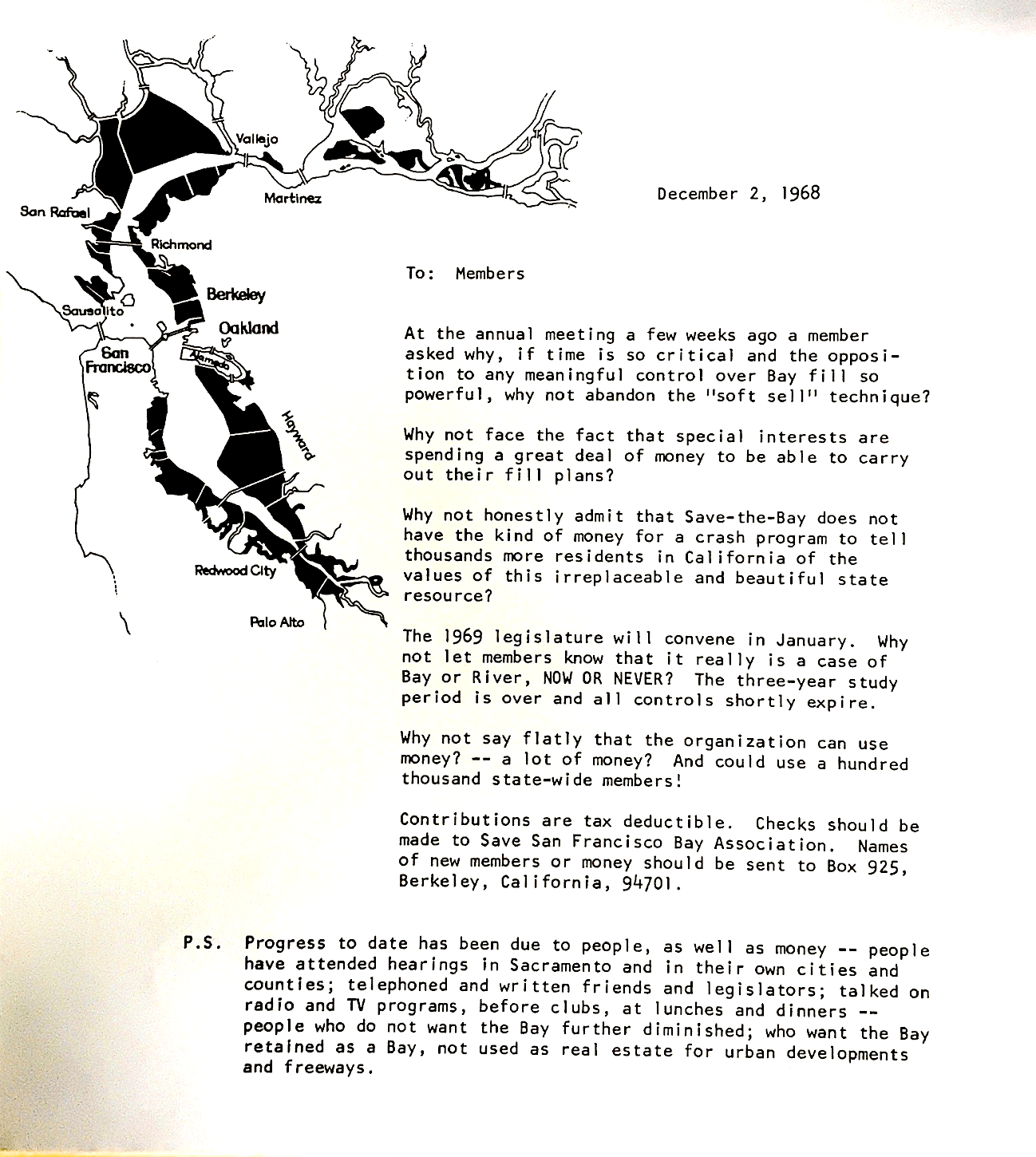How Three Women Saved the San Francisco Bay
This picture, which appeared in the Oakland Tribune in 1961, predicted what the San Francisco Bay would look like in 2020, with the black color representing parts of the Bay filled for development. The map, based on the areas of the Bay that were shallow enough to fill, was written about in detail by reporter Ed Salzman in an article titled “Our Shrinking Bay.” When Salzman wrote this article, he had no idea the impact it would have.

Shortly after Salzman’s article was published, a woman named Esther Gulick brought some almond cookies to her friend Catherine Kerr’s house. The two women knew each other through their husbands, who were both members of the UC Board of Regents. They had both read Salzman’s article, and they started discussing it. Kerr asked Gulick if she had time to do something about it, and Gulick said yes. They were joined by Sylvia McLaughlin, another Board of Regents member’s wife. They had an uphill battle ahead of them.
Approximately 70% of the Bay was less than 20 feet deep, meaning it could be filled and developed. The City of Berkeley had plans to fill 2,000 acres of the Bay, which would double the size of the city. There were almost no environmental laws or regulations, and almost all of the shoreline was owned by private companies who could legally do whatever they wanted with the Bay.
The three women started by calling up existing environmental organizations to see if they would be interested in taking on this issue. The organizations were supportive but said they had too much on their plates to take on this daunting fight. They encouraged the women to start their own organization, and the Save the San Francisco Bay Association was born.
The fight began. The Association sent out letters about the issue, urging people to join their organization, and got an incredible response: almost 90% of the people who received letters joined the organization. To raise money, they charged a $1 annual fee ($10 in today’s money) to receive newsletters about the Association. They conducted flyer campaigns, started phone chains, and consulted with scientists, lawyers, and politicians. Their hard work paid off after the election of 1963, in which the newly elected members to the Berkeley City Council were more conscious of preserving the Bay.
In 1964, Kerr met with Senator Eugene McAteer and convinced him that the effects of filling the Bay must be studied before any projects should be started. Because of this conversation, a bill was passed to create the San Francisco Bay Conservation Study Commission, which had four months and $75,000 to study the impacts of filling the Bay and then report its findings to the legislature.
The press and public paid attention to this process, as Save The Bay and other environmental groups sent many letters to legislators. Ultimately, the Commission recommended more research be done and recommended a new agency, the San Francisco Bay Conservation and Development Commission, which would have four years to prepare a plan for the Bay and would have the authority to grant or deny permits for all Bay filling. After the four years was up, the plan presented to legislators was to make the Commission permanent to prevent the filling of the Bay.
Kerr, Gulick, and McLaughlin were worried that this plan would not pass in the California legislature, as Republican governor Ronald Reagan had a lot of influence and didn’t have a great record on environmental issues. Thankfully, Reagan supported the plan, granting it bipartisan support. In 1969, it passed, making the Commission permanent and protecting about 70% of San Francisco Bay. This was the ultimate victory for Kerr, Gulick, and McLaughlin, and the reason why we can enjoy the beautiful San Francisco Bay.
Save The Bay did not stop there. They have continued, to this day, to fight against developers with plans to fill the Bay. The group has greatly expanded access to the Bay. In 1961, only six miles of shoreline were accessible to the public. Now, we have a necklace of oceanside parks, connected by the 500-mile Bay Trail. One of these parks, McLaughlin Eastshore State Park, was actually named after Sylvia McLaughlin, one of the founders of Save The Bay.

In 2000, Save The Bay helped prevent San Francisco International Airport from filling the Bay to build runways. In 2016, they supported Measure AA, a nine-county $12 per year parcel tax for 20 years funding shoreline protection and restoration projects, which passed with 70 percent of the vote. Now, Save The Bay continues to focus on preserving the San Francisco Bay as well as tackling other issues in the Bay Area such as climate change, affordable housing, and public transportation. They focus not just on the shoreline but on urban tree-planting and restoration as well. They also have a volunteer team that works to restore wetlands and teach kids in schools.
Esther Gulick died in 1995, Katherine Kerr in 2010, and Sylvia McLaughlin in 2016, just months before her 100th birthday. McLaughlin continued to attend protests well into her 90s. The legacy of these three women lives on in the organization they founded. Thanks to McLaughlin, Gulick, Kerr, and their community, humans and animals alike can enjoy the San Francisco Bay. Even though the odds were stacked against them, they went up against wealthy companies and powerful politicians–and won. Not only did they manage to save the Bay, but they also changed the status quo, bringing environmental issues to the forefront of California’s politics. This incredible story shows us that smart, community-oriented grassroots activism has the power to preserve the planet and change the world.
Sources
Alexandra, Rae. “The 1960s Women Whose Environmental Activism Saved the Bay.” KQED, 22AD, https://www.kqed.org/arts/13911567/the-1960s-women-whose-environmental-activism-saved-the-bay.
Katz, Leslie. “Sixty Years of Saving San Francisco Bay.” San Francisco Examiner, 22 Apr. 2021, https://www.sfexaminer.com/archives/sixty-years-of-saving-san-francisco-bay/article_6a377f20-a68f-53b2-90e2-5902ddda7c9c.html.
McLaughlin, Sylvia, et al. “Esther Gulick, Catherine Kerr, and Sylvia McLaughlin: ‘Saving San Francisco Bay: Past, Present, and Future.’” 1988 Horace M. Albright Lecture in Conservation: “Saving San Francisco Bay: Past, Present, and Future”, 1988, https://nature.berkeley.edu/site/lectures/albright/1988.php.


